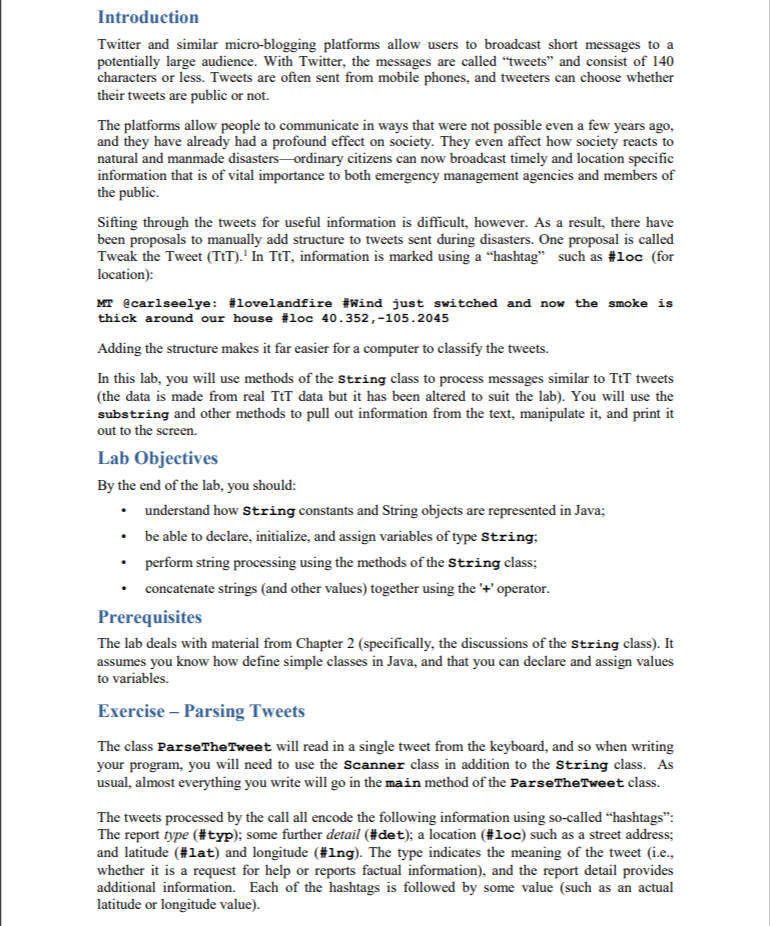
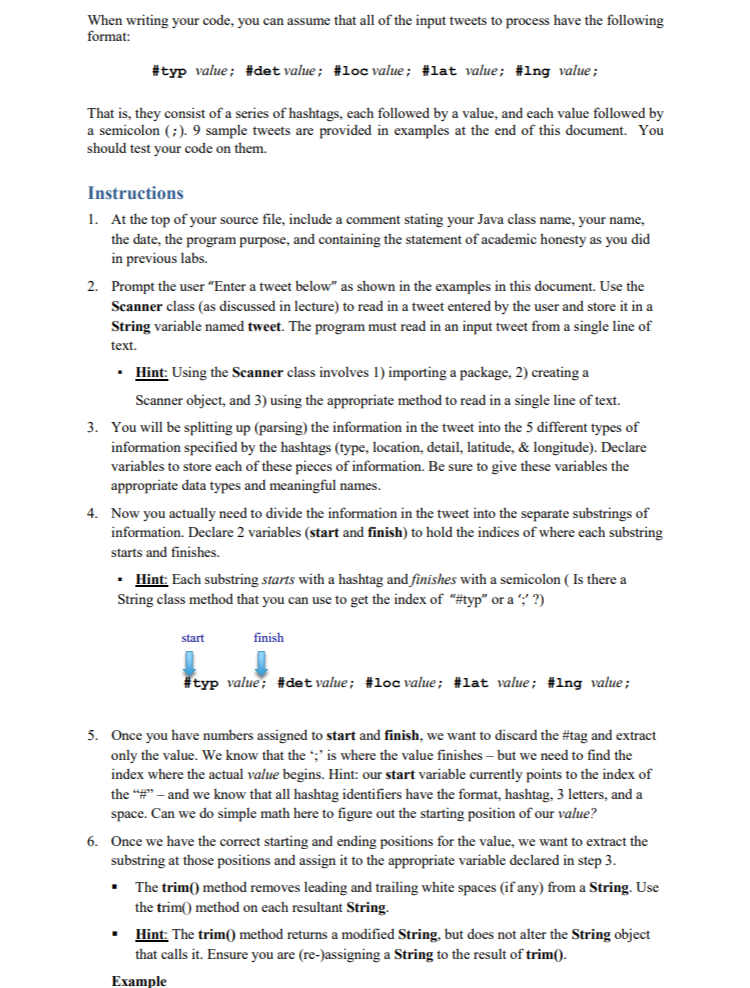
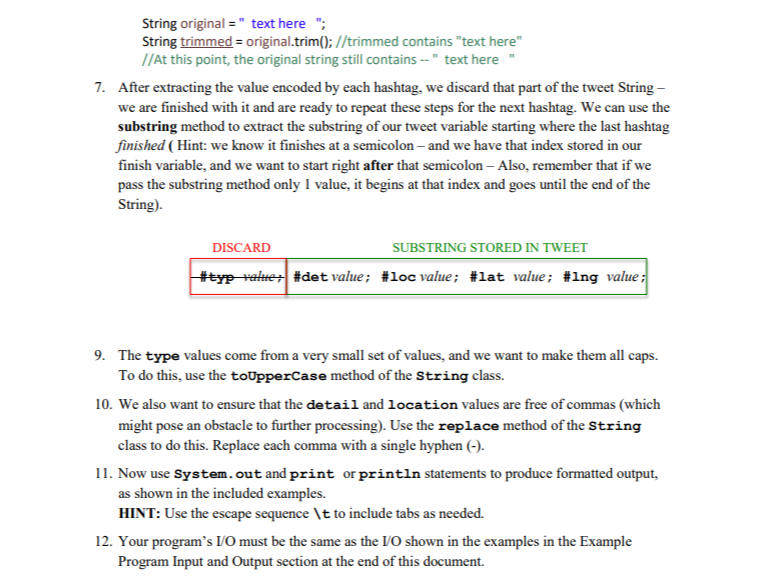
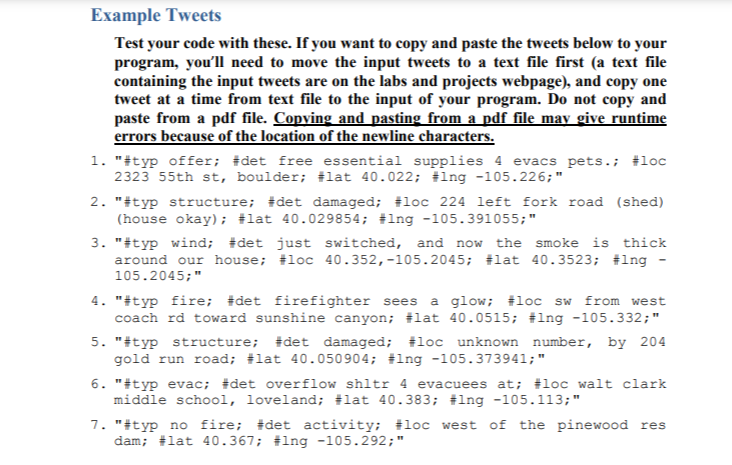
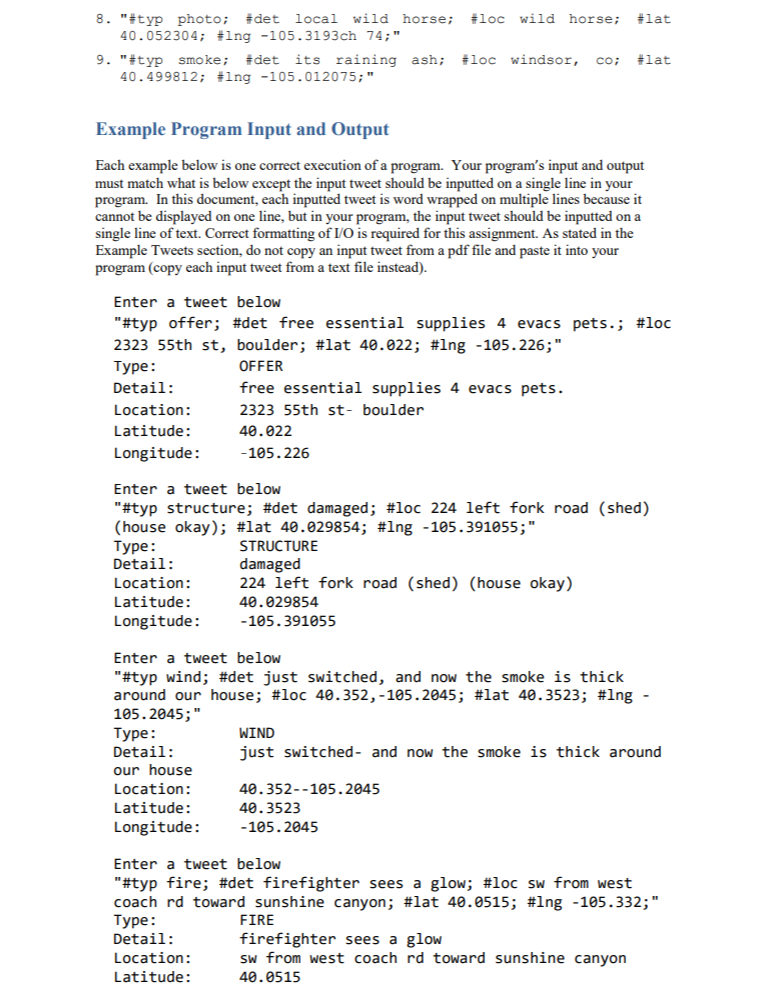
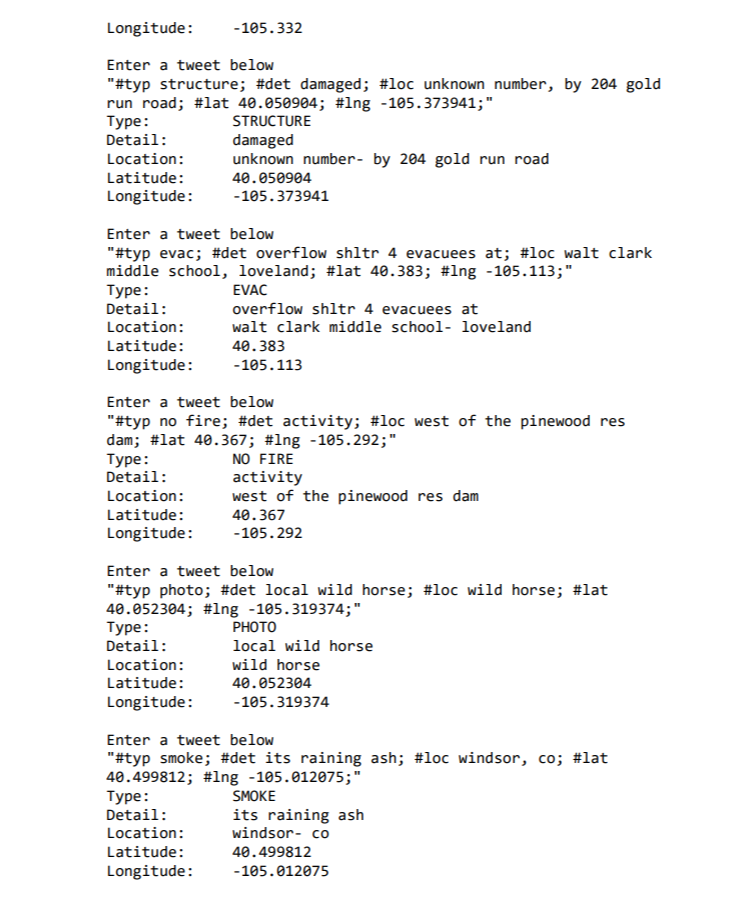
Introduction Twitter and similar micro-blogging platforms allow users to broadcast short messages to a potentially large audience. With Twitter, the messages are called "tweets and consist of 140 characters or less. Tweets are often sent from mobile phones, and tweeters can choose whether their tweets are public or not. The platforms allow people to communicate in ways that were not possible even a few years ago, and they have already had a profound effect on society. They even affect how society reacts to natural and manmade disasters ordinary citizens can now broadcast timely and location specific information that is of vital importance to both emergency management agencies and members of the public. Sifting through the tweets for useful information is difficult, however. As a result, there have been proposals to manually add structure to tweets sent during disasters. One proposal is called Tweak the Tweet (TtT).' In TtT, information is marked using a hashtag" such as #loc (for location): MT @carlseelye: #lovelandfire #Wind just switched and now the smoke is thick around our house #loc 40.352,-105. 2045 Adding the structure makes it far easier for a computer to classify the tweets. In this lab, you will use methods of the String class to process messages similar to TtT tweets (the data is made from real TtT data but it has been altered to suit the lab). You will use the substring and other methods to pull out information from the text, manipulate it, and print it out to the screen. Lab Objectives By the end of the lab, you should: understand how String constants and String objects are represented in Java; be able to declare, initialize, and assign variables of type String, perform string processing using the methods of the String class; concatenate strings and other values) together using the 't' operator. Prerequisites The lab deals with material from Chapter 2 (specifically, the discussions of the String class). It assumes you know how define simple classes in Java, and that you can declare and assign values to variables. Exercise - Parsing Tweets The class ParseThe Tweet will read in a single tweet from the keyboard, and so when writing your program, you will need to use the Scanner class in addition to the String class. As usual, almost everything you write will go in the main method of the ParseTheTweet class. The tweets processed by the call all encode the following information using so-called hashtags": The report type (#typ); some further detail (#det); a location (#loc) such as a street address; and latitude (#lat) and longitude (#ing). The type indicates the meaning of the tweet (i.e., whether it is a request for help or reports factual information), and the report detail provides additional information. Each of the hashtags is followed by some value (such as an actual latitude or longitude value). When writing your code, you can assume that all of the input tweets to process have the following format: #typ value ; #det value ; #loc value ; #lat value; #ing value; That is, they consist of a series of hashtags, each followed by a value, and each value followed by a semicolon (;). 9 sample tweets are provided in examples at the end of this document. You should test your code on them. Instructions 1. At the top of your source file, include a comment stating your Java class name, your name, the date, the program purpose, and containing the statement of academic honesty as you did in previous labs. 2. Prompt the user "Enter a tweet below" as shown in the examples in this document. Use the Scanner class (as discussed in lecture) to read in a tweet entered by the user and store it in a String variable named tweet. The program must read in an input tweet from a single line of text. Hint: Using the Scanner class involves 1) importing a package, 2) creating a Scanner object, and 3) using the appropriate method to read in a single line of text. 3. You will be splitting up (parsing) the information in the tweet into the 5 different types of information specified by the hashtags (type, location, detail, latitude, & longitude). Declare variables to store each of these pieces of information. Be sure to give these variables the appropriate data types and meaningful names. 4. Now you actually need to divide the information in the tweet into the separate substrings of information. Declare 2 variables (start and finish) to hold the indices of where each substring starts and finishes. Hint: Each substring starts with a hashtag and finishes with a semicolon ( Is there a String class method that you can use to get the index of "typ" or a :'?) start finish #typ value; #det value; #loc value; #lat value; #ing value ; 5. Once you have numbers assigned to start and finish, we want to discard the #tag and extract only the value. We know that the ;' is where the value finishes - but we need to find the index where the actual value begins. Hint: our start variable currently points to the index of the ""- and we know that all hashtag identifiers have the format, hashtag, 3 letters, and a space. Can we do simple math here to figure out the starting position of our value? 6. Once we have the correct starting and ending positions for the value, we want to extract the substring at those positions and assign it to the appropriate variable declared in step 3. The trim() method removes leading and trailing white spaces (if any) from a String. Use the trim() method on each resultant String Hint: The trim() method returns a modified String, but does not alter the String object that calls it. Ensure you are (re-)assigning a String to the result of trim(). Example . String original="text here "; String trimmed = original.trim(); //trimmed contains "text here" //At this point, the original string still contains -" text here 7. After extracting the value encoded by each hashtag, we discard that part of the tweet String - we are finished with it and are ready to repeat these steps for the next hashtag. We can use the substring method to extract the substring of our tweet variable starting where the last hashtag finished (Hint: we know it finishes at a semicolon - and we have that index stored in our finish variable, and we want to start right after that semicolon Also, remember that if we pass the substring method only 1 value, it begins at that index and goes until the end of the String). DISCARD SUBSTRING STORED IN TWEET #typ value; #det value; #loc value; #lat value; #ing value; 9. The type values come from a very small set of values, and we want to make them all caps. To do this, use the toUpperCase method of the String class. 10. We also want to ensure that the detail and location values are free of commas (which might pose an obstacle to further processing). Use the replace method of the String class to do this. Replace each comma with a single hyphen(-). 11. Now use System.out and print or println statements to produce formatted output, as shown in the included examples. HINT: Use the escape sequence \t to include tabs as needed. 12. Your programs 10 must be the same as the I/O shown in the examples in the Example Program Input and Output section at the end of this document. Example Tweets Test your code with these. If you want to copy and paste the tweets below to your program, you'll need to move the input tweets to a text file first (a text file containing the input tweets are on the labs and projects webpage), and copy one tweet at a time from text file to the input of your program. Do not copy and paste from a pdf file. Copying and pasting from a pdf file may give runtime errors because of the location of the newline characters. 1. "#typ offer; det free essential supplies 4 evacs pets.; #loc 2323 55th st, boulder; #lat 40.022; #Ing -105.226;" 2. "#typ structure; det damaged; #loc 224 left fork road (shed) (house okay); #lat 40.029854; #Ing -105.391055;" 3. "#typ wind; det just switched, and now the smoke is thick around our house; #loc 40.352,-105.2045; #lat 40.3523; #lng - 105.2045;" 4. "#typ fire; det firefighter sees a glow; #loc sw from west coach rd toward sunshine canyon; #lat 40.0515; #lng -105.332;" 5. "#typ structure; det damaged; #loc unknown number, by 204 gold run road; #lat 40.050904; #ing -105.373941;" 6. "#typ evac; det overflow shltr 4 evacuees at; #loc walt clark middle school, loveland; #lat 40.383; #lng -105.113;" 7. "#typ no fire; det activity; loc west of the pinewood res dam; #lat 40.367; #lng -105.292;" #lat 8. "#typ photo; #det local wild horse; #loc wild horse; 40.052304; #Ing -105.3193ch 74;" 9. "#typ smoke; #det its raining ash; #loc windsor, CO; 40.499812; #lng -105.012075;" #lat Example Program Input and Output Each example below is one correct execution of a program. Your program's input and output must match what is below except the input tweet should be inputted on a single line in your program. In this document, each inputted tweet is word wrapped on multiple lines because it cannot be displayed on one line, but in your program, the input tweet should be inputted on a single line of text. Correct formatting of I/O is required for this assignment. As stated in the Example Tweets section, do not copy an input tweet from a pdf file and paste it into your program (copy each input tweet from a text file instead). Enter a tweet below "#typ offer; #det free essential supplies 4 evacs pets.; #loc 2323 55th st, boulder; #lat 40.022; #Ing -105.226;" Type: OFFER Detail: free essential supplies 4 evacs pets. Location: 2323 55th st- boulder Latitude: 40.022 Longitude: -105.226 Enter a tweet below "#typ structure; #det damaged; #loc 224 left fork road (shed) (house okay); #lat 40.029854; #Ing - 105.391055;" Type: STRUCTURE Detail: damaged Location: 224 left fork road (shed) (house okay) Latitude: 40.029854 Longitude: -105.391055 Enter a tweet below "#typ wind; #det just switched, and now the smoke is thick around our house; #loc 40.352,-105.2045; #lat 40.3523; #Ing - 105.2045;" Type: WIND Detail: just switched- and now the smoke is thick around our house Location: 40.352--105.2045 Latitude: 40.3523 Longitude: - 105.2045 Enter a tweet below "#typ fire; #det firefighter sees a glow; #loc sw from west coach rd toward sunshine canyon; #lat 40.6515; #lng -105.332;" Type: FIRE Detail: firefighter sees a glow Location: sw from west coach rd toward sunshine canyon Latitude: 40.0515 Longitude: -105.332 Enter a tweet below "#typ structure; #det damaged; #loc unknown number, by 204 gold run road; #lat 40.050904; #Ing -105.373941;" Type: STRUCTURE Detail: damaged Location: unknown number- by 204 gold run road Latitude: 40.050904 Longitude: -105.373941 Enter a tweet below "#typ evac; #det overflow shltr 4 evacuees at; #loc walt clark middle school, loveland; #lat 40.383; #lng - 105.113;" Type: EVAC Detail: overflow shltr 4 evacuees at Location: walt clark middle school- loveland Latitude: 40.383 Longitude: -105.113 Enter a tweet below "#typ no fire; #det activity; #loc west of the pinewood res dam; #lat 40.367; #lng - 105.292;" Type: NO FIRE Detail: activity Location: west of the pinewood res dam Latitude: 40.367 Longitude: -105.292 Enter a tweet below "#typ photo; #det local wild horse; #loc wild horse; #lat 40.052304; #lng -105.319374;" Type: PHOTO Detail: local wild horse Location: wild horse Latitude: 40.052304 Longitude: -105.319374 Enter a tweet below "#typ smoke; #det its raining ash; #loc windsor, co; #lat 40.499812; #Ing -105.012075;" Type: SMOKE Detail: its raining ash Location: windsor- co Latitude: 40.499812 Longitude: -105.012075












